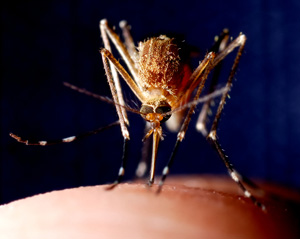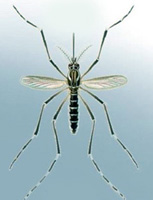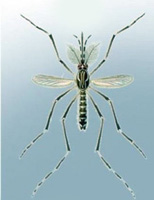Tiny Mosquito
The Difference between Male Mosquitoes and Female Mosquitoes
|
Although it is impossible to tell the physical differences between male and female mosquitoes with the naked eye, it is easy enough to find the distinctness when the mosquito is placed under a microscope or magnifying glass.
Speaking
of Looks
In terms of physical appearance, the mosquito’s proboscis,
a long, needle-like antenna that extends from the area of its mouth, is
the best indication of the insect’s gender. Male mosquitoes have
a feather-like proboscis, while the proboscis of the female mosquito is
relatively smooth, not bushy. The hair on the antenna is called antennal flagellum. Believe it or not, this hair assists with hearing. Male mosquitos use their flagellum to help locate female mosquitos by the (very) quiet buzzing sounds they emit. The sound waves trigger the flagellum to move, this movement is then carried through to Johnston’s organ, which identifies the speed of other mosquitoes’ beating wings and distinguishes between males and females as well as other mosquito species.
Does One Outlive the Other?
Normally, the lifespan of the female mosquito is much longer
than that of the male mosquito. In their natural environment, female mosquitoes
can live as long as 1 to 2 weeks. However, in captivity, female mosquitoes
can live over a month, depending on the correct level of humidity, proper
temperature, and whether or not it can successfully nourish itself with
blood.
On the other hand, male mosquitoes usually live for approximately 1 week, even when they are placed under ideal environmental and nutritional conditions.
To help avoid both female and male mosquitoes from flourishing near you and your home, read our tips on mosquito prevention.
 Do both Genders Suck Blood?
Do both Genders Suck Blood?
The answer is no. Male mosquitoes survive by feeding on flower
nectar and sweet juices. Female mosquitoes not only feed on various sugars
for energy, but also require the nutrition of blood for the development
of their eggs. Without regular intakes of blood, their ability to reproduce quickly diminishes.
The Egg Development Process of the Common Female Mosquito
The typical female mosquito bites humans and mammals and sucks blood in order to acquire enough protein to produce her eggs. When you fall prey to a mosquito bite, there are fortunately a few natural as well as store-bought remedies that will help tame the itch! Once a blood meal is obtained, she will rest a few days until the eggs are fully developed. Once they are ready, the female lays the eggs and then continues her search for a new host. Read here for more details on the life cycle of a mosquito.
Some Particular Types of Female Mosquitoes
Even though most species of female
mosquitoes need blood for their offspring, some
types can actually lay a batch of eggs without
a blood meal. Others do not drink the blood
of mammals, but will feed only on the blood
of amphibians or other insects. Then, there
are a few species of female mosquitoes that
do not drink blood at all; like male mosquitoes,
they only feed on nectar and other sugars.
Home - Mosquitoes - Bites - Control - Diseases - Resources - Site Map

